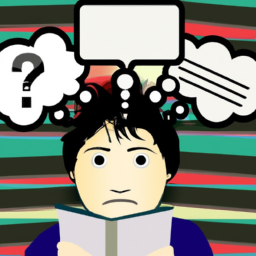Did you realize that we spend about six years of our lives dreaming? Yes, that’s correct, a whole six years!
But have you ever noticed that reading in your dreams is nearly impossible? Despite the vivid and sometimes bizarre scenarios we experience while sleeping, our brains seem to struggle with the task of reading. I can explain why reading in dreams is challenging.
In this article, we will delve into the science behind dreaming and explore the reasons behind our inability to read in our dreams. From the perception and processing of visual information to language and logic processing, we will break down the complex workings of the brain and its role in our dream state.
So, let’s dive in and discover why reading in our dreams is such a rare feat.
Key Takeaways
- The brain’s limited activity levels during sleep affect cognitive processes, making it difficult to process language efficiently in dreams.
- Visual and emotional information is prioritized in dreaming, while logical thinking and decision making are less active.
- Reading in dreams is nearly impossible due to the brain’s lack of focus on language and logic processing during dreaming.
- Dreams are simulations of reality that help us process and integrate our experiences, emotions, and memories, and can reveal hidden emotions, desires, and fears.
Overview of Dreaming and Brain Activity
Dreaming involves a complex interplay of brain activity, which can’t be fully understood yet. While we’re asleep, our brain is still active, generating a variety of experiences we perceive as dreams.
This activity involves several regions of the brain, including the prefrontal cortex, the amygdala, and the hippocampus. These regions are responsible for different aspects of our mental and emotional processes, and their interactions shape the content and intensity of our dreams.
One of the key features of dreaming is the perception and processing of visual information, which is often vivid and intense. However, this perception is different from the way we perceive the world while we’re awake. For instance, we may see objects that don’t exist in reality or experience situations that are impossible in the physical world.
Moreover, the processing of visual information in dreams is more fragmented and less coherent than in waking life. Therefore, it’s not surprising that we can’t read in our dreams, as reading requires a high degree of focused attention and cognitive processing that’s not compatible with the fragmented and chaotic nature of dreaming.
Perception and Processing of Visual Information
I find it fascinating how our brains process visual information during sleep. Even though we can’t read in our dreams, our brains are still actively processing information.
Research has shown that certain parts of the brain are even more active during sleep than when we’re awake.
Active Parts of the Brain During Sleep
While you’re asleep, your brain’s prefrontal cortex, responsible for conscious thought and decision-making, is less active than when you’re awake, according to a study by the University of Wisconsin-Madison.
This study found that the prefrontal cortex was only one of many regions that were less active during sleep. Here are three other regions of the brain that are less active during sleep:
-
The parietal cortex, which is responsible for sensory processing and spatial awareness.
-
The temporal lobe, which is responsible for memory consolidation and processing of sound.
-
The occipital lobe, which is responsible for visual processing.
Despite these regions being less active during sleep, the brain is still active and processing information.
This leads us to the question of how visual information is processed in dreams.
How Visual Information is Processed in Dreams
Visual information in my dreams is processed through activity in the brain’s occipital lobe, which is responsible for visual processing even during sleep. However, the way this information is processed is different from when I’m awake.
In my dreams, the images I see are often distorted or fragmented, and can shift rapidly from one scene to another. This is because during REM sleep, which is when most dreaming occurs, the brain’s prefrontal cortex, responsible for logic and decision-making, is less active.
This means that the visual information I see in my dreams is not being processed in the same way as when I’m awake. Instead of logic and decision-making, my brain is more focused on emotions and memories during dreaming.
This is why my dreams can sometimes seem nonsensical or illogical, but still be emotionally impactful. It’s important to note that the lack of prefrontal cortex activity during REM sleep can also impact the way language and logic are processed in dreams.
Language and Logic Processing
Our brain processes language and logic differently during dreaming, which may contribute to our inability to read in dreams. Here are some reasons why:
-
The prefrontal cortex, responsible for logical thinking and decision making, is less active during REM sleep when most dreaming occurs.
-
Language processing is impaired during dreaming, making it difficult to form coherent sentences or understand complex ideas.
-
The brain prioritizes processing visual and emotional information during dreaming, which may reduce the capacity for language and logic processing.
-
The absence of external stimuli, such as reading material, may also contribute to the brain’s lack of focus on language and logic processing during dreams.
As we explore the role of memory in dreaming, it’s important to consider how our brain’s processing of language and logic during dreams may impact our ability to remember and recall dream content.
The Role of Memory in Dreaming
It’s crucial to recognize the significance of memory in dreaming, as it influences our ability to recall and interpret dream content. Our dreams are essentially a product of our brain’s processing and integration of memories, experiences, and emotions.
When we sleep, our brain consolidates and organizes memories, which can then be incorporated into our dreams. This means that our dreams can contain elements from our past experiences, both recent and distant, as well as emotions and feelings that we may not even be consciously aware of.
Furthermore, the role of memory in dreaming can also affect our ability to remember our dreams upon waking. If we don’t encode our dreams properly in our memory, we may forget them entirely or only recall fragments of them.
This is why it’s important to actively try to remember and record our dreams, as it can help us gain insight into our subconscious mind. With this understanding of the significance of memory in dreaming, we can begin to explore the concept of dreams as simulations, which we’ll delve into next.
Dreams as Simulations
Imagine how fascinating it’d be to experience your dreams as vivid simulations. This would allow you to explore and interact with different scenarios and emotions in a safe and controlled environment. Dreams are thought to be simulations of reality that help us process and integrate our experiences, emotions, and memories. In this sense, dreams are not simply random images but rather complex mental processes that serve important psychological functions.
One of the most intriguing aspects of dreams is the fact that we cannot read in them. This ability seems to be absent or severely impaired in dreams, but we take it for granted in waking life. The science behind this phenomenon is still not fully understood, but several theories have been proposed to explain why we cannot read in our dreams.
The Science Behind Reading in Dreams
As I mentioned earlier, dreams can be seen as simulations of reality. However, our brains don’t always simulate reality accurately.
One example of this is the fact that we’re unable to read in our dreams. The reason for this is that the part of the brain responsible for reading, the occipital lobe, isn’t as active during sleep as it is when we’re awake.
This means that even if we see writing in our dreams, our brain may not be able to process it as text. Instead, we might see jumbled letters or symbols that our brain tries to make sense of.
But why does the occipital lobe become less active during sleep? And what other factors contribute to our inability to read in our dreams? Let’s explore these questions in more depth.
Why We Can’t Read in Our Dreams
I’ve always wondered why I can’t read in my dreams, and it turns out there are some scientific reasons for it.
It has to do with how our brain processes language and logic, which are limited during sleep.
While we may have some brain activity during dreaming, it’s not enough to fully engage in reading and comprehension.
The Role of Language and Logic Processing
You can’t read in your dreams because your brain processes language and logic differently while you sleep, making it nearly impossible to comprehend written text.
During sleep, the parts of the brain responsible for language and logic processing are not as active as they are when we are awake. This means that our brain has a hard time creating coherent sentences and understanding the meaning behind words and phrases.
This limitation of dream language and logic processing can evoke feelings of frustration, confusion, and even fear in individuals who experience vivid dreams. It can be unsettling to try to read something in a dream and not be able to make sense of the words on the page.
However, this is a natural occurrence that is simply a result of the brain’s different activity levels during sleep.
The Limitations of Brain Activity During Sleep
When the brain is in a state of sleep, its activity levels are limited, which can affect various cognitive processes. One of these processes is the ability to read and process language. During sleep, the brain is not able to process language as efficiently as it does when we are awake. This is why we often cannot read or understand written text in our dreams.
To better understand this limitation, let’s imagine a scenario where we are trying to read a book in our dream. In the table below, we can see how this scenario might play out emotionally for us. As we try to read the book, we might start to feel frustrated, confused, and overwhelmed by the words on the page. This emotional response is a result of our brain struggling to process and understand the language in our dream.
Despite the limitations of brain activity during sleep, there are other ways that we can communicate in our dreams. These methods often involve visual or auditory cues, such as seeing or hearing something that represents a certain idea or emotion. In the next section, we will explore these alternative forms of communication and how they can be used to better understand our dreams.
Other Ways of Communicating in Dreams
Although reading may not be possible in dreams, other forms of communication can convey complex ideas and emotions. For example, in my own dreams, I often communicate with others through a type of telepathy where words are not necessary. Instead, I can sense their thoughts and emotions, and they can sense mine. This type of communication feels more intimate and immediate than spoken language, and it allows for a deeper understanding of the other person.
Additionally, dreams often use symbolic imagery to convey meaning. Objects, people, and situations in dreams may represent something else entirely, and interpreting these symbols can be a fascinating and enlightening process. By exploring the symbolism in our dreams, we can gain insight into our subconscious thoughts and emotions, which can help us better understand ourselves and our lives.
As I explore the significance of dreaming, I am reminded of the many ways in which our dreams can reveal hidden truths about ourselves and the world around us.
The Significance of Dreaming
The significance of dreaming goes beyond just being a source of entertainment during sleep, as it provides a unique window into the workings of our subconscious minds. Through our dreams, we can access hidden emotions, desires, and fears that we may not be aware of in our waking lives. This can help us process and deal with these emotions in a safe and controlled environment.
Moreover, dreams can also serve as a source of inspiration and creativity. Many artists, writers, and musicians have drawn inspiration from their dreams, using them as a source of new ideas and perspectives. In fact, some of the greatest works of art and literature were born from the artist’s dream world. Therefore, it’s important to pay attention to our dreams and the messages they may be trying to convey to us, whether it’s about our inner selves or the world around us.
| Column 1 | Column 2 | Column 3 | ||
|---|---|---|---|---|
| Dreams can reveal hidden emotions and fears. | Dreams can inspire creativity and new ideas. | Paying attention to our dreams can help us better understand ourselves and the world around us. | Therefore, keeping a dream journal and reflecting on our dreams can be a valuable tool for personal growth and self-discovery. |
Frequently Asked Questions
What are some common themes in people’s dreams?
According to a study, common themes in dreams are falling, being chased, and being unable to move. These dreams may reflect our anxieties and fears. But why reading isn’t possible in dreams still remains a mystery.
Can dreaming affect our physical health?
Dreaming can affect physical health by impacting sleep quality, mood, and cognitive function. Poor sleep can lead to a weakened immune system, increased risk of illness, and decreased productivity. Addressing sleep issues can improve overall health.
How do we know if we’re dreaming or awake?
Did you know that the average person spends about 6 years of their life dreaming? It’s hard to distinguish dreams from reality, but reality checks like looking at your hands or trying to read can help.
Is it possible to control our dreams?
Yes, it is possible to control our dreams through lucid dreaming techniques. By recognizing that one is dreaming and practicing techniques such as reality checks and visualization, one can gain control over their dream world.
Can dreams predict the future?
Dreams cannot predict the future. While they may contain symbolic representations of our hopes, fears, and desires, they are not a reliable source of prophecy.
Conclusion
Well, I guess it’s safe to say that reading in dreams is pretty much impossible. But it’s not all bad news, because our brain has found other ways to communicate with us while we sleep.
Whether it’s through vivid imagery, sounds, or emotions, our dreams are constantly trying to tell us something.
So, next time you find yourself in a dream trying to read a book or a sign, don’t get too frustrated. Instead, embrace the other forms of communication that your brain is using to convey its message.
Who knows, it might just be a more colorful and creative way of expressing itself. After all, dreams are a fascinating and mysterious part of our lives, and we should cherish them for the unique experiences they provide.










